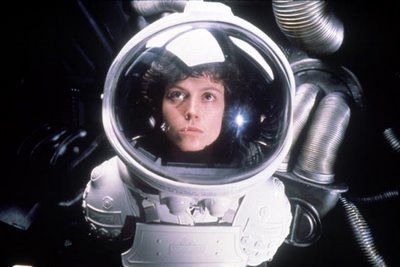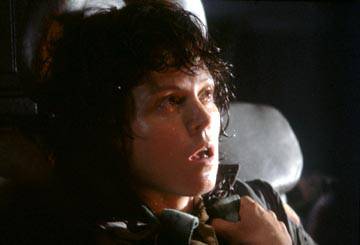Alien (1979)
DIRECTOR: Ridley Scott
CAST:
Sigourney Weaver, Tom Skerritt, Ian Holm, Veronica Cartwright, Yaphet Kotto, Harry Dean Stanton, John Hurt
REVIEW:
In some ways, Alien could be seen as moving the Halloween-style slasher horror movie into outer space, but its achievement was more than that. While the best-known sci-fi at the time was the fairly lightweight Star Wars and Star Trek, with Alien Ridley Scott looked through the glass darkly. The movie is a dark experience, a slow-moving thriller that gradually and inexorably builds up the suspense until certain scenes and the climax in particular ascend to nerve-wracking tension. It’s the kind of movie that’s dark and harrowing to the extent that it’s questionable to call it conventionally “enjoyable”, but it is undeniably skillful filmmaking that shows a keen understanding of building suspense.
Our cast is the seven-person crew of the Nostromo, a cargo ship on its way back to Earth. Captain Dallas (Tom Skerritt), Warrant Officer Ripley (Sigourney Weaver), Executive Officer Kane (John Hurt), navigator Lambert (Veronica Cartwright), science officer Ash (Ian Holm), and engineers Bret (Harry Dean Stanton) and Parker (Yaphet Kotto) are brought out of hyper-sleep early when the ship’s computer, “Mother”, intercepts a signal from a nearby planet that may be an SOS…or a warning. While checking out the signal that leads them to a crashed alien ship containing a collection of eggs, Kane is attacked by a spidery creature that springs from one of the eggs and attaches itself to his face. After a short period in the infirmary, the creature releases Kane, and things seem to return to normal. But the horror has only begun.
 A few things distinguish Alien from other thrillers. One is the deliberateness of the pacing. Scott refuses to rush any of his scenes, particularly the ones where the suspense builds and we suspect an attack is imminent, but also others detailing the early crew interactions and the ship landing on the alien planet. It’s over twenty minutes into the movie before anything that can be called exciting happens, but not only does this allow us to observe a little of the crew’s interactions, it allows Scott to build up the ominous tone. Expectedly, the ship is huge and dimly-lit, with lots of dark, spacious chambers full of hiding places for a creature loose onboard. In keeping with the overall restraint, the violence is generally not particularly graphic, although one scene makes up for the lack of gore in any other: the indelible scene of the alien’s birth probably seared itself into the minds of the audience members and came as a genuinely shocking moment. The acting and dialogue is matter-of-fact and to-the-point, and there is scarcely anything resembling comic relief.
A few things distinguish Alien from other thrillers. One is the deliberateness of the pacing. Scott refuses to rush any of his scenes, particularly the ones where the suspense builds and we suspect an attack is imminent, but also others detailing the early crew interactions and the ship landing on the alien planet. It’s over twenty minutes into the movie before anything that can be called exciting happens, but not only does this allow us to observe a little of the crew’s interactions, it allows Scott to build up the ominous tone. Expectedly, the ship is huge and dimly-lit, with lots of dark, spacious chambers full of hiding places for a creature loose onboard. In keeping with the overall restraint, the violence is generally not particularly graphic, although one scene makes up for the lack of gore in any other: the indelible scene of the alien’s birth probably seared itself into the minds of the audience members and came as a genuinely shocking moment. The acting and dialogue is matter-of-fact and to-the-point, and there is scarcely anything resembling comic relief.
Another distinction is the cast and characters. None of the seven-member cast were big names, and they avoid various caricatures and stock character types: there is no romantic subplot and no one is trying to be glamorous, exaggeratedly heroic, sexy, or comic relief, and the crew member who ends up the central character and SPOILER WARNING the sole survivor is a woman, Ripley, who (especially with the 1986 James Cameron follow-up, Aliens ) would go on to become an iconic action heroine and help pave the way for other tough leading ladies like Linda Hamilton’s Sarah Connor in the Terminator films. Ironically, Sigourney Weaver could arguably be said to give one of the less polished performances, with an occasionally uncertain line delivery, but she generates a suitable intensity as we reach the harrowing climax. The other woman in the cast, Veronica Cartwright, is likewise a little overwrought (though try getting her blood-curdling scream out of your head), but the others do effective jobs delineating their basic character traits: Tom Skerritt is the cool, collected Captain Dallas (one wonders how surprising it was for 1979 audiences that he doesn’t save the day), Harry Dean Stanton and Yaphet Kotto are the grumbling engineers who drag their feet on repairs and gripe incessantly about their salaries, and John Hurt is probably the most unfortunate crew member of all (Hurt has probably the least screentime, but one of the most gruesomely unforgettable death scenes in cinematic history). The most subtle and intriguing performance is by Ian Holm, who does a good low-key job of getting us to view him with suspicion without doing anything overt. Unsurprisingly, Ash turns out to have secrets, in fact a few more than we’re expecting. Ripley might be the heroine, but Ash is the supporting character we keep our eye on.
 There are a number of standout sequences in Alien, beginning with the discovery of the crashed alien ship and the collection of eggs. Then there is the gruesome birth scene no viewer is likely to forget any time soon, and the alien’s first attack, an almost maddeningly tense sequence that drags out the suspense until viewers will be on the edge of their seat (or hiding behind it). Arguably the most suspense-generating scene in the movie comes with the time-honored little blip on the motion sensor steadily drawing closer, and the climax, with Ripley running frantically down dark narrow corridors, alarms blaring, builds to such a harrowing pitch that by the time the end credits roll, viewers may find themselves nearly exhausted. Scott, who had only previously directed one other movie (1977’s The Duelists) shows Hitchcockian levels of meticulously building the suspense and tension with gradual but inexorable relentlessness. And of course, there is one last ‘just when you thought it was safe to relax’ jolt. At least for most of the movie, our glimpses of the creature are kept brief, incomplete, and shadowy. This is not to mask poor effects–the creature is believable, even decades later–but it is an effective use of the “less is more” approach. Along the way there is also a not so surprising revelation, immediately followed by a more surprising revelation, and a little commentary common to this type of movie about unscrupulous corporations willing to sacrifice human lives to obtain a product (this would be expanded on more in the following installments). The alien itself, a creation of designer H.R. Giger and played by tall African actor Bolaji Badejo, is a singularly grotesque creation, with its phallic head, drooling jaws opening to reveal smaller jaws inside, and black, almost insectoid body, and together with the facehuggers impregnating unsuspecting victims, represents a work of macabre imagination.
There are a number of standout sequences in Alien, beginning with the discovery of the crashed alien ship and the collection of eggs. Then there is the gruesome birth scene no viewer is likely to forget any time soon, and the alien’s first attack, an almost maddeningly tense sequence that drags out the suspense until viewers will be on the edge of their seat (or hiding behind it). Arguably the most suspense-generating scene in the movie comes with the time-honored little blip on the motion sensor steadily drawing closer, and the climax, with Ripley running frantically down dark narrow corridors, alarms blaring, builds to such a harrowing pitch that by the time the end credits roll, viewers may find themselves nearly exhausted. Scott, who had only previously directed one other movie (1977’s The Duelists) shows Hitchcockian levels of meticulously building the suspense and tension with gradual but inexorable relentlessness. And of course, there is one last ‘just when you thought it was safe to relax’ jolt. At least for most of the movie, our glimpses of the creature are kept brief, incomplete, and shadowy. This is not to mask poor effects–the creature is believable, even decades later–but it is an effective use of the “less is more” approach. Along the way there is also a not so surprising revelation, immediately followed by a more surprising revelation, and a little commentary common to this type of movie about unscrupulous corporations willing to sacrifice human lives to obtain a product (this would be expanded on more in the following installments). The alien itself, a creation of designer H.R. Giger and played by tall African actor Bolaji Badejo, is a singularly grotesque creation, with its phallic head, drooling jaws opening to reveal smaller jaws inside, and black, almost insectoid body, and together with the facehuggers impregnating unsuspecting victims, represents a work of macabre imagination.
With its confined setting of a small crew on one ship menaced by a singular alien, Alien is the most simple and least ambitious of the four installments, but it stands not only as the opening of a sc-fi horror franchise, but simply as a highly skillful exercise in nightmarish horror and suspense and one of the most harrowing film experiences ever made.
***1/2